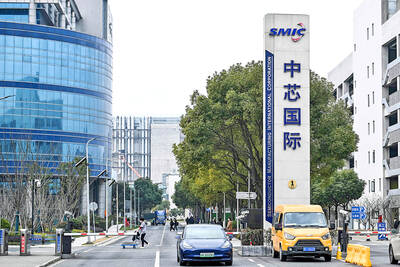Taipei Times (TT): The global economic momentum gradually lost ground over the second half of last year. How did this impact DHL Express’ business and sales?
Jerry Hsu (許克威): Despite the weak global economy, the company’s revenues in the Asia-Pacific region remained steady with double-digit growth last year amid relative strong demand from Asia’s emerging markets.
Meanwhile, the US market showed strong-than-expected growth last year, with full-year revenues in the region up 25 percent. The [low] base effect would be the main factor driving up growth in the US last year, as the company quit the domestic express business in the US market a year earlier.
As for the European region, annual expansion in revenues did slow last year, but momentum in some Eastern European countries supported the company’s sales to prop up growth.
TT: How do you view the business outlook for the company this year?
Hsu: Although economic momentum may continue to slow in the first half of the year, I’m confident that the company’s sales will keep growing this year following still growing revenues in the fourth quarter of last year.
Since we had expected a downturn in DHL’s business, the better-than-expected performance indicates a good start for this year.
For the Asia-Pacific region, we expect Southeast Asian countries, including India, to show the highest growth this year, while China might post the strongest expansion in terms of overall volume.
In addition, revenues in Europe will probably continue to grow this year, which means the question is: How much will the growth level be? instead of: Will it grow?
I expect the company to outperform its peers, just like we did in the fourth quarter of last year. We have to keep increasing revenues by controlling costs, while expanding market share amid deepening localization, which will help us understand our customers better.
TT: How about the outlook for the industry this year?
Hsu: Basically, for the express delivery sector, in which DHL has about a 30 percent global market share, business is expected grow steadily even if the global economy slows.
That is because the company transports all kinds of goods for industries as varied as the high-tech, automotive and fashion sectors. If demand falls in one industry, that might be made up for with increasing demand in another.
As for global forwarding freight and supply chain, it is difficult to say how the overall industry will go this year, but we will definitely pursue a higher market share in these two sectors as well.
As of the end of last year, DHL held an 8.5 percent market share in the global supply chain business, with 12.9 percent in the air forwarding freight sector, followed by 9.1 percent in ocean forwarding and 2.1 percent in road forwarding.
TT: Do you have any plans to expand in the Asia-Pacific region?
Hsu: DHL’s newly built hub for North Asia, which is located at Shanghai Pudong International Airport, will be officially launched in June or July.
It will be the company’s seventh hub worldwide. Currently, DHL has six hubs, located in Bahrain, Cincinnati, Hong Kong, Lagos, Leipzig and Miami.
The hub in Shanghai is second only in terms of size to the Leipzig hub, while its operating volume is expected to be the third largest, after the hubs in Leipzig and Hong Kong.
TT: Will the launch of the Shanghai hub drag down the traffic volume in Hong Kong?
Hsu: It won’t since the traffic volume at Hong Kong’s hub is over capacity, which means either increasing capacity in Hong Kong or transferring some volume to Shanghai is necessary.
We have invested US$400 million since 2007 to expand the Hong Kong hub’s facilities to manage the growing trading volume in Asian markets, especially in China.
TT: What will be DHL’s plan for China during the near term?
Hsu: For now, the company focuses more on the B2B [business-to-business] market in China, as average consumers in China are not accustomed to express services with high speed, high reliability, but also high prices.
However, we will keep setting up new offices, facilities and routes in China. We plan to expand our coverage to 30 percent of third-tier cities in China by 2015.
TT: How do you view Taiwan’s market this year? Are there any expansion plans for DHL in Taiwan this year?
Hsu: We took a 35 percent market share in Taiwan last year, making us the largest logistics company locally, with revenues growing despite the overall volume of Taiwan’s air transport sector dropping 8 percent as of the end of November.
For this year, we still expect double-digit growth in revenues and are eyeing the launch of new routes, such as Taipei Songshan Airport to Shanghai, in the first half of the year.
Since the launch of new routes needs government approval on air rights, we will opt to cooperate with local airlines, such as China Airlines [Ltd] (中華航空) and EVA [Airways Corp] (長榮航空), for transporting goods.

SEMICONDUCTOR SERVICES: A company executive said that Taiwanese firms must think about how to participate in global supply chains and lift their competitiveness Taiwan Semiconductor Manufacturing Co (TSMC, 台積電) yesterday said it expects to launch its first multifunctional service center in Pingtung County in the middle of 2027, in a bid to foster a resilient high-tech facility construction ecosystem. TSMC broached the idea of creating a center two or three years ago when it started building new manufacturing capacity in the US and Japan, the company said. The center, dubbed an “ecosystem park,” would assist local manufacturing facility construction partners to upgrade their capabilities and secure more deals from other global chipmakers such as Intel Corp, Micron Technology Inc and Infineon Technologies AG, TSMC said. It

People walk past advertising for a Syensqo chip at the Semicon Taiwan exhibition in Taipei yesterday.

NO BREAKTHROUGH? More substantial ‘deliverables,’ such as tariff reductions, would likely be saved for a meeting between Trump and Xi later this year, a trade expert said China launched two probes targeting the US semiconductor sector on Saturday ahead of talks between the two nations in Spain this week on trade, national security and the ownership of social media platform TikTok. China’s Ministry of Commerce announced an anti-dumping investigation into certain analog integrated circuits (ICs) imported from the US. The investigation is to target some commodity interface ICs and gate driver ICs, which are commonly made by US companies such as Texas Instruments Inc and ON Semiconductor Corp. The ministry also announced an anti-discrimination probe into US measures against China’s chip sector. US measures such as export curbs and tariffs

The US on Friday penalized two Chinese firms that acquired US chipmaking equipment for China’s top chipmaker, Semiconductor Manufacturing International Corp (SMIC, 中芯國際), including them among 32 entities that were added to the US Department of Commerce’s restricted trade list, a US government posting showed. Twenty-three of the 32 are in China. GMC Semiconductor Technology (Wuxi) Co (吉姆西半導體科技) and Jicun Semiconductor Technology (Shanghai) Co (吉存半導體科技) were placed on the list, formally known as the Entity List, for acquiring equipment for SMIC Northern Integrated Circuit Manufacturing (Beijing) Corp (中芯北方積體電路) and Semiconductor Manufacturing International (Beijing) Corp (中芯北京), the US Federal Register posting said. The